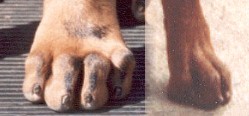Shoulder Blade sloping forward and downward at a 45-degree angle to the ground meets the upper arm at an angle of 90 degrees. Length of shoulder blade and upper arm are equal. Height from elbow to withers approximately equals height from ground to elbow. Legs seen from front and side, perfectly straight and parallel to each other from elbow to pastern; muscled and sinewy, with heavy bone. In normal pose and when gaiting, the elbows lie close to the brisket. Pasterns firm and almost perpendicular to the ground. Dewclaws may be removed. Feet well arched, compact, and catlike, turning neither in nor out.
Shoulder blade sloping forward and downward at a 45 degree angle – Although this angulation is impossible to get, it indicates the importance placed on the angulation of the shoulder. This angulation allows for the beautiful, smooth flow of the neck into the shoulder. The Doberman standard repeatedly stresses the balance of all the parts – length of shoulder blade to upper arm are equal; the height from elbow to withers approximately equals height from ground to elbow. Many Dobermans have the entire shoulder assembly pushed forward with a short upper arm. The better the layback of shoulder, the longer and smoother the neck will appear (it should still be in proportion to everything else). Again, the depth of body should be equal to the length of leg. This does NOT allow for the high stationed dog that many find so appealing. Applying the standard takes precedence over personal preference. When the proportions are correct, the dog appears shorter on leg and longer in body. The dog that has more length of leg and less depth of body generally may give the illusion of being square, but in reality, is really too short backed.
The legs are straight, which means they don’t have the curves of the achondroplastic breeds. While the correct pastern appears almost straight, there is a “slight”, although very slight bend in the pastern. A pastern that is too straight or long cannot absorb the impact of gaiting. It is NOT correct!
Heavy bone does not mean big boned, it refers to a round bone versus an oblong bone, which has the appearance of “light” bone. The 1948 standard stated “legs… muscled and sinewy with round, heavy bone”. In normal pose and when gaiting, the elbows lie close to the brisket–look at the dog from the back and you should be able to see the elbow fit tightly into the brisket. There should be no air space between the elbow and body. If you can see through the area or it looks like you can get a hand in there, the lay on is not correct and the dog will probably stand wide, move wide or toe in and not gait properly.
Feet well arched, compact and catlike, turning neither in nor out – a dog with large or flat feet is like a car with flat tires. Well arched feet that are held strongly together indicate tight tendons for good shock absorption. Long toes are associated with longer tendons and usually weaker (or more let down) pasterns. This will be evident when the dog moves. Toes should be short and tight. Large feet will not only have the appearance of sloppy movement, but cannot cushion or absorb as well as the short, tight toes. Judge the “turning neither in nor out” when the dog is moving. Dogs can be trained to stand properly, but they will move naturally.
|
Two examples of cat feet. |
|
|
|
Left is a young dog and right is an adult |
Click the following links to read more articles in the “Dobermans in Detail” series:
by Linka Krukar submitted by Marj Brooks
